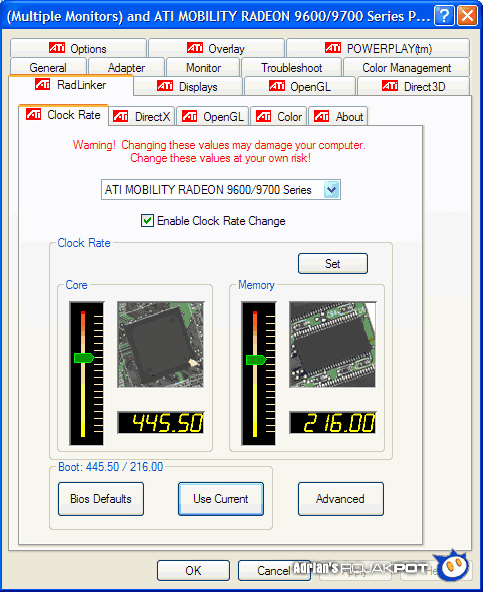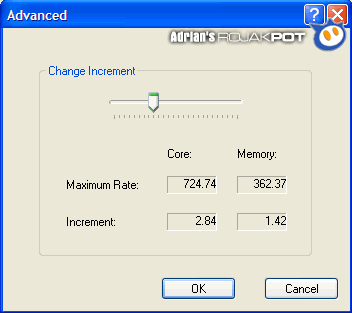Overclocking The Mobility Radeon 9700
To overclock the ATI Mobility Radeon 9700, I used the excellent RadLinker utility. For those who are not familiar with RadLinker, here's a short description from the creator of RadLinker :
RadLinker is new tweaker/linker for ATI Radeon based graphics cards. RadLinker features:
- Absolutely no programs running in the background
- Does not bloat the registry
- Per game/program settings
- Control over process priority
- Per game/program clock rate settings
- As many unique game profiles as your computer can hold
- Custom profiles for all your games
RadLinker allows you to create a "RadLink", a special kind of shell link (a.k.a. shortcut) to your games/programs that allows you to change it's individual settings. A RadLink will look and act just like a normal shortcut except it's property settings can be custom tailored for your video settings.

With RadLinker, all you need to do is adjust the slider and test the stability of the GPU and memory chips.
Of course, with ATI graphics cards, you don't get neat 1MHz increments. Instead, each step up or down the slider is determined by a Change Increment option.
You can access the Change Increment option by clicking on the Advanced button. The Change Increment window will then pop up :

The Change Increment slider allows you to adjust the increase in MHz for each step up or down the clock speed slider in the main RadLinker window. When you reduce the increment, the maximum rate decreases as well. If you want to overclock more, then you have to increase the increment.
Overclocking Results
After stress-testing the GPU and the memory chips, I managed to overclock the GPU by 15.8% to 515.7MHz.
I also managed to get the memory chips to run at 248.4MHz. That is an increase of 15% over the default clock speed used in the BenQ Joybook 7000 but unfortunately, it's still 11.6MHz short of the official memory clock speed. Looks like BenQ used slower memory chips than were recommended by ATI.
| Actual
Specs |
Overclocked
Specs |
Increase
(MHz) |
Increase
(%) |
|
| Core
Clock |
445.5 MHz |
515.7 MHz |
70.2 MHz |
15.8 % |
| Fill
Rate |
1782 MTexels/s |
2062.8 MTexels/s |
280.8 MTexels/s |
15.8 % |
| Memory
Clock |
216 MHz |
248.4 MHz |
32.4 MHz |
15.0 % |
| Memory
Bandwidth |
6.91 GB/s |
7.95 GB/s |
1.04 GB/s |
15.0 % |
So, there we have it - a GPU that's pretty overclockable but memory chips that cannot even reach the official clock speed of 260MHz. Even at a glance, it's pretty obvious that the overclocked Mobility Radeon 9700 will be starved for memory bandwidth.
To find out if that's true, as well as check the actual improvement in performance from overclocking, I benchmarked the reclocked Mobility Radeon 9700 with a variety of synthetic and real world tests. Let's see if overclocking the Mobility Radeon 9700 really helps improve performance!
<<< ATI Mobility Radeon 9700, Our Testbed : Previous Page | Next Page : The Test System, Benchmark Settings, Testing Methodology >>>







 Add to Reddit
Add to Reddit
